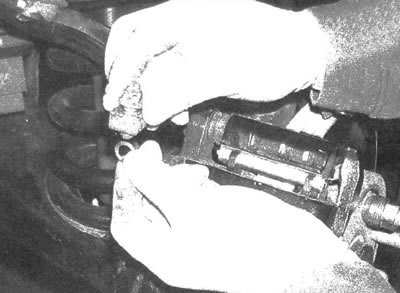Warning: Dust generated by pad wear is hazardous to health. Do not blow it off with compressed air or inhale dust. When servicing the brake system, it is recommended to wear a protective mask or respirator. Do not use benzine or solvents for cleaning. Use only a special cleaner to clean brake system components.
Removal
1. Loosen the front or rear wheel nuts, jack up the front or rear of the vehicle and install jack stands. Place chocks under the wheels of the opposite axle. Remove the rear or front wheel.
2. Unscrew the bolt of the brake supply hose connector and disconnect the hose from the caliper. The removed sealing washer can be discarded (see illustration). Immediately plug the hose to prevent system clogging and excessive brake fluid loss.

4.2. There are sealing washers on both sides of the brake supply hose fitting; When connecting the hose, it is necessary to replace the washers
Note: If the caliper is being removed to gain access to other components, do not disconnect the brake hose from it. Hang the caliper on a piece of wire, avoiding tension on the brake hose (see illustration 5.2).
3. Unscrew the mounting bolts and disconnect the caliper from the bracket. When removing the rear caliper, in order to unscrew the mounting bolts, it is necessary to fix the guide pins with an open-end wrench (see illustration 3.5e).
Installation
4. Installation is carried out in the reverse order of removal. Place new sealing washers on each side of the brake supply hose fitting. Tighten the fitting bolt, as well as the caliper mounting bolts to the required torques.
5. Bleed the brake system (see _ subsection 8).
Note: If the brake hose has not been disconnected, do not bleed the hydraulic system.
Make sure hose connections are tight. Before you begin normal operation of the vehicle, make sure that its braking system is working properly.
